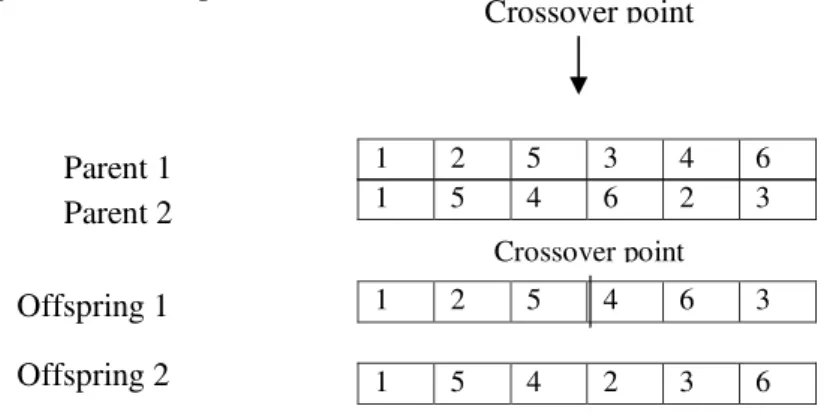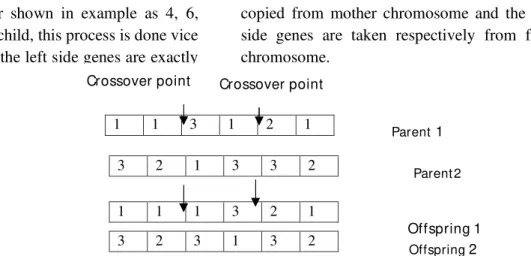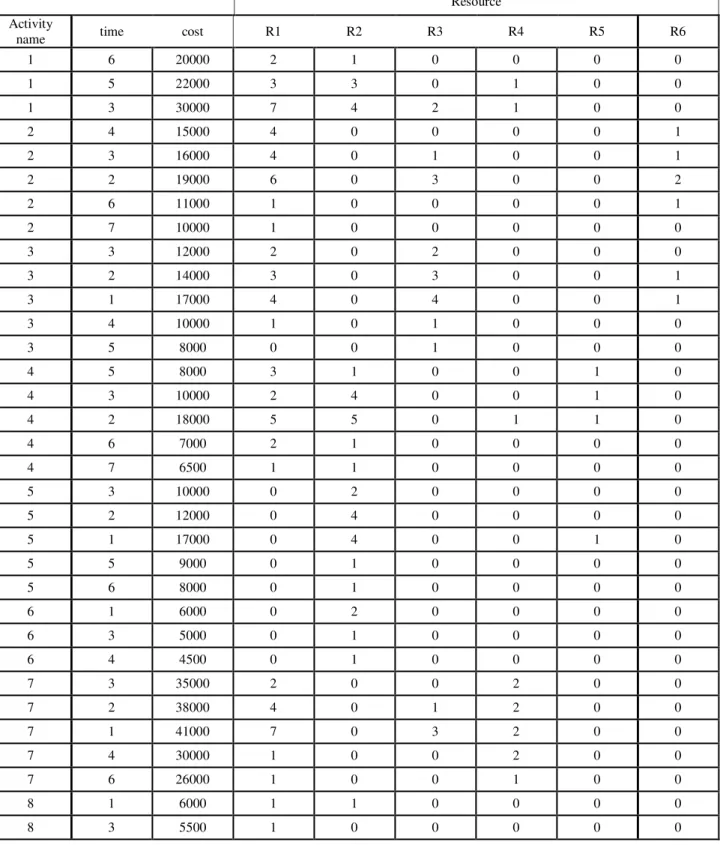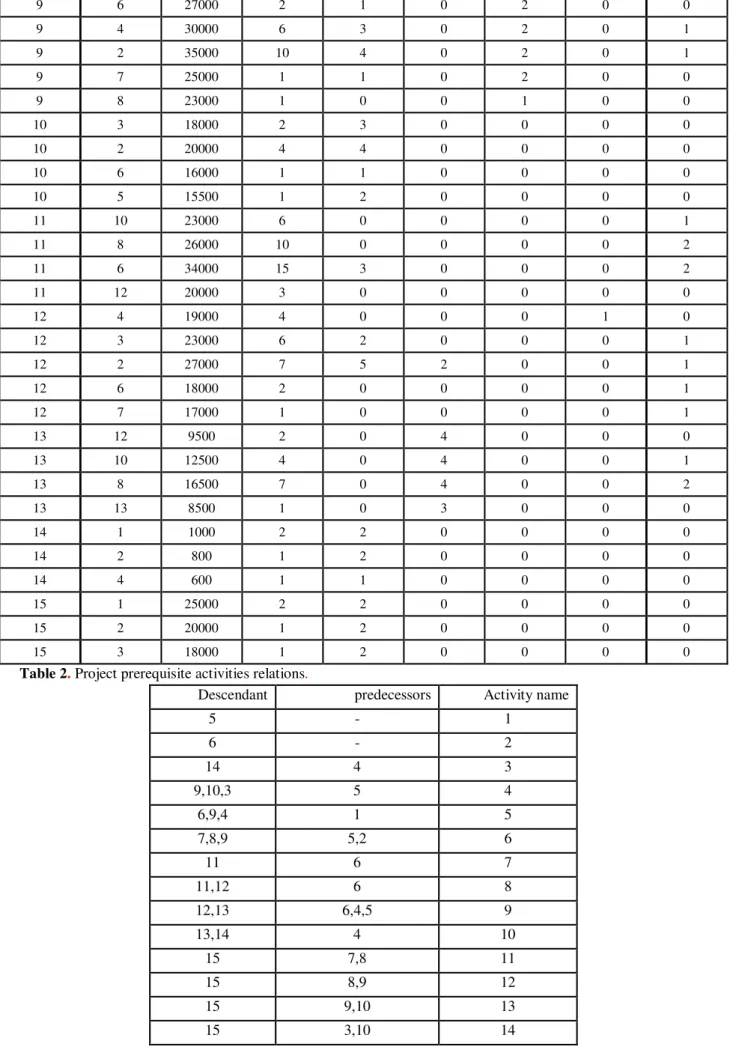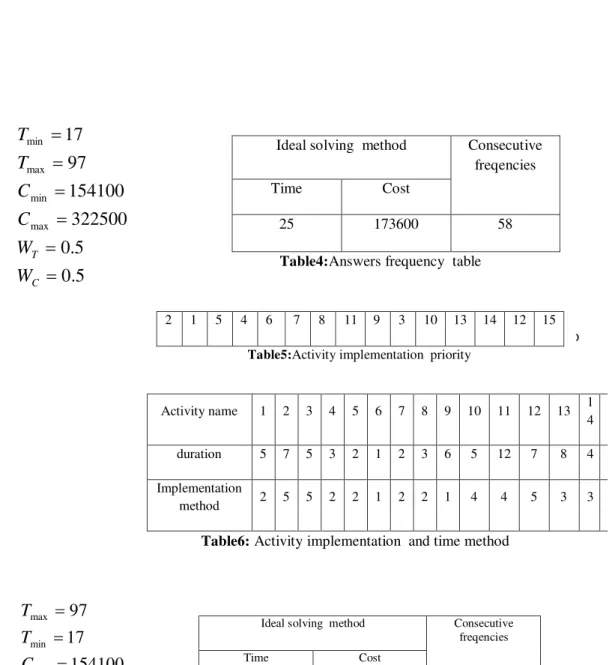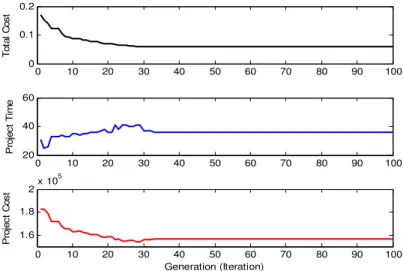Vol-7, Special Issue3-April, 2016, pp1245-1255 http://www.bipublication.com
Case Study
Project Scheduling problem using metaheuristic algorithm
Amir Seyedan Anby
Department of industrial management, Firoozkooh branch,
Islamic Azad University, Firoozkooh, Iran ABSTRACT
In this paper we solve Time-Cost trade-off project, in a way that sees decision maker preferences and cares about resource restriction simultaneously. Cause of being a part of NP-hard questions we use a meta-initiative multi index genetic algorithm method for model making and solving it. This paper estimates completing project time watching both time and cost elements, also initiative SJS method is being used for resource attribution. In this order with caring aforementioned purposes we calculate project completing time, and decision maker could run to ideal answers by changing time and cost indexes importance. This question was coded in Matlab software and cause of being complicated it reaches to an ideal answer in acceptable time.
Key words: Multi-attribute decision making, time-cost trade-off, resource constraint, multi-attribute genetic algorithm, critical path method.
INTRODUCTION
For determining project scheduling program one of the common methods is CPM (Critical Path Method). Changing project time is impossible in this method. On the other hand, determining project time is based on resources boundless assumption and vice versa to the real world. Many jobs have been done to eliminate mentioned defects; the most considerable one is time-cost trade-off method initiation and resources attribution. Project administration resources including manpower, machinery, etc in real construction world are limited. For counting resources restriction construction scheduling has to have contained resources attribution. Lots of math and probing methods have been employed to solve time-cost trade-off question and attribute resources. Generally, all probing methods are dependent on question and do not guarantee optimum answer [1]. On the other hand, by question dimensions extension and complication math methods lose their performance, although they guarantee optimum answer [2]. By employing math method,
changing probing methods principles to
restrictions and purpose function is necessary and has some lapses possibly [3].
Subject Discuss
construction time with or without resources limitation [16] and machine learning and GA application in time-cost trade-off question solving [17]. But still in all models optimizing has been kept as a single-criterion. So, need to use multi-criterion algorithm was totally clear.
Some multi-criterion genetic algorithm
applications are multi-purpose GA application in time-cost optimizing [3] and multi-criterion optimizing model for construction scheduling by using GA [2]. But still in all mentioned models decision maker preferences in using the best item has not been counted.
Multi-criterion genetic algorithm model for TCT question solving supposing resources limitation
Genetic algorithm simulates living organisms' natural genetic process. Noticeable GA power
and its ability in one item random using are like a device to lead searching up in the unknown air to the better answer. This searching has an exact leading for parents searching by using exchange and mutation footsteps resulting children be better than fathers [18].
GA Model Properties A: Time-cost relation
For making GA model more like real world, time and cost relation has been counted separately.
B: Chromosome Appearance
Due to resource limitation, doing activities and their way of doing ordering are decision variants, so we face to two chromosome appearances. In this way, chromosome is in two parts, first one the activities doing ordering, and second one information round their method.
n: activities number
i: activity namei
m
: activity implementation method numberThis kind of answer could be known as mutation
chromosome. In every block of this
chromosome there's a natural number. Naturally this chromosome has 2n blocks that n blocks are in right and n blocks are in left. Left blocks chromosome number show activities doing priority ordering, that means the activity in block 1 has the highest priority and activity in block n has the least priority.Right side chromosome blocks number also respectively
show activities
1 to
n , and eachactivity
m
ishows that activity method whichcosts money, time and specific resources. With this foundation for a set of m are defined for
each
i activity andm
i is one of them. C: Resources AllocationIn this paper SGS method, an initiative method has been used to estimate project time regardless of resources limitation. SGS method uses a half complete scheduling program to build a practical scheduling program based on resources limitation criterion. Half complete scheduling program is a kind of program which is created by random numbers producer algorithm in an incipient manner and the total project time is unknown but shows the activities priority due to
each other. SGS method is split to two methods itself. They are named serial SGS and parallel SGS. Next, we'll explain both[23].In most scientific studies to solve resources attribution question which have used meta-initiative methods, serial SGS has been used for project time calculating [19, 20]. Some others have used parallel SGS [21].The reason serial SGS has been used in most scientific researches is that in parallel method not all optimizing answers fit in question room; but in serial method they all do [20]. Many experimental researches have shown that serial method have better results than parallel method at the time many scheduling are done for a project [22].Possibly in low algorithm repetition parallel method gives us better answers than serial method. Totally we have no idea for sure which method is better, serial or parallel. So, in this paper this matter has been seen from a different perspective. This different angle of sight is using both serial and parallel, because that's impossible to foresee which method is better.
Fitness Function
In single-index optimizing there's an explanation of solving method, but not in multi-indexes.
n
m
1
nm
...
2
m
1
m
n
1
n ....2
1
First DM (Decision Making) puts its preferences due to time and cost indexes, then indexes weight due to DM preferences are calculated by entropy method. Suppose decision maker preferences matrix (DM) on indexes is like this:
Tij Cij
Matrixprefernce
Then, supposing DM preferences compatible with function indexes, weight function is like this, using entropy method:
w
tw
c
W
,
In this method every itemsadequacy is obtained by:
j j j
ij j
W
r
W
x
value
fitness
In this formula rij is non-scale fitness i order
item and j order index. If fuzzy method is used for non-scaling, by then, last items fitness is obtained by:
c t
c t
w w
C C
C x C w T
T T x T w x fitness
min max
min
min max
min ( )
) (
Which variants in aforementioned relations are:
min max
,
c
c
are cost criterion maximum.T
max,
T
minare time criterion maximum.C (x) and T (x) are time and cost criteria value X order item. Also parameter is a very small random number which is for blocking zero to zero division. DM decision maker could reach a group of ideal answers by changing its preferences for time and cost indexes.
Selection Operator
This operator randomly chooses two chromosomes from present group as parents till breeding happens like them. Employed method in this paper is so-called genetic algorithm method, roulette-wheel selection.
Crossover Operator
Chromosome structure has two parts in this paper; cause of having two parts, Crossover operator
chromosome model used in this research has two different parts, too. In this way we explore operator which operates on first part:
Figure 1. Crossover operator on first part
In figure 1 example as it shown two parent chromosome are chosen and ready for crossover operation. From this operation we have two children born. By making crossover point specific, first child is born which in there father genes are before intersection point. That is exactly copied in child chromosome. Now for making genes from child chromosome which is in the right we must use mother genes. But mother right chromosome could not be copied in
child, because some action will be repeated two times in gene or may some prerequisite relations lose their order. To overcome this problem we use mother chromosomes order to fill child right side chromosomes. This method in chart 1 is shown also, first genes 1, 2 and 5 from father are copied into child chromosome and then to fill the right side genes from child chromosome we use activities that are not used in child chromosome, which those are in mother
6 4 3 5 2 1
3 2 6 4 5 1
3 6 4 5 2 1
6 3 2 4 5 1
Crossover point
Crossover point
Parent 1 Parent 2
Offspring 1
Amir Seyedan Anby 1248
chromosome order shown in example as 4, 6, and 3. For second child, this process is done vice versa. This means the left side genes are exactly
copied from mother chromosome and the right side genes are taken respectively from father chromosome.
1 2 1 3 1 1
Figure 2. Crossover operator on chromosome second part. In chart 2 crossover operator which operates on parent chromosome second part is shown. This operator is a two-point crossover operator which is not different from other two-point operators. To make new children, genes from both sides of crossover point are kept fixed and genes between chromosome crossover points are replaced by each other. Like fig 2, crossover operator is not certainly operated on all answers as parents, but rather its operating quantity is controlled by one of the genetic algorithm
parameters called
c.Also crossover does notcertainly happen on the both chromosome parts, but rather this operation is completely independent on both parts. So, crossover operation could happen on both parts, one of them or none of them.
Mutation Operator
This operator makes little differences in child answers to block algorithm trouble in areal
optimizing. So, it is tried to spread
chromosomes in all answer space till algorithm have the chance to find real optimizing answer. For this algorithm, mutation operator in one gene from each chromosome layer makes a difference. Reason to mutate in chromosome first part is to change the place of two chromosomes beside each other, in a way that activity prerequisite relations do not lose their order. In this project mutation operator has the ability to make answers in use and practical, and do not disturb activities prerequisite relations. Child chromosome before mutation
Mutation Point
1 2 5 3 4 6
Child chromosome after mutation
1 2 3 5 4 6
Chart 3. Mutation operator on chromosome first part.
In second part it's necessary for mutation operator to make healthy children; it means form of mutated chromosomes must be in a way that the mutated activity way of doing be in real too. Mutation of chromosome second part is shown in chart 4:
Child chromosome before mutation
Child chromosome after mutation
Chart 4. Mutation operator on second part chromosome. Mutation operation certainly is not done on all
child answers, but rather it is controlled by a genetic algorithm parameter called
m. Also2 3 3 1 2 3
1 2 3 1 1 1
2 3 1 3 2 3
4 1 2 3 2 1
4 1 2 1 2 1
Parent 1
Parent 2
Mutation point
Crossover point Crossover point
Offspring 1
mutation operation is not definitely done on every part of the chromosome, but rather this operation is completely independent on every part. So, mutation operation could be done on every part, one of the parts or none of them. Case Study: To study the present genetic algorithm performance in solving these kinds of questions, this time we have an example
question to test presented algorithm. To do this, a project with 15 activities is chosen. These activities respectively are shown with numbers 1 to 15, which in those question prerequisite relations is shown in table 2, maximum resources volume in table 3 and project activities doing possible times in Table 1.
Table 1. Activity doing possible times and cost.
Amir Seyedan Anby 1250 0 0 2 0 1 2 27000 6 9 1 0 2 0 3 6 30000 4 9 1 0 2 0 4 10 35000 2 9 0 0 2 0 1 1 25000 7 9 0 0 1 0 0 1 23000 8 9 0 0 0 0 3 2 18000 3 10 0 0 0 0 4 4 20000 2 10 0 0 0 0 1 1 16000 6 10 0 0 0 0 2 1 15500 5 10 1 0 0 0 0 6 23000 10 11 2 0 0 0 0 10 26000 8 11 2 0 0 0 3 15 34000 6 11 0 0 0 0 0 3 20000 12 11 0 1 0 0 0 4 19000 4 12 1 0 0 0 2 6 23000 3 12 1 0 0 2 5 7 27000 2 12 1 0 0 0 0 2 18000 6 12 1 0 0 0 0 1 17000 7 12 0 0 0 4 0 2 9500 12 13 1 0 0 4 0 4 12500 10 13 2 0 0 4 0 7 16500 8 13 0 0 0 3 0 1 8500 13 13 0 0 0 0 2 2 1000 1 14 0 0 0 0 2 1 800 2 14 0 0 0 0 1 1 600 4 14 0 0 0 0 2 2 25000 1 15 0 0 0 0 2 1 20000 2 15 0 0 0 0 2 1 18000 3 15
Table 2. Project prerequisite activities relations.
15 11,.12,13,14
-Table 3. Resources maximum supply.
Resource maximum
R1 R2
R3 R4
R5 R6
infinite 2
1 2
4 5
Solving example question by suggested algorithm
To schedule and program case question by multi-index genetic algorithm first question information are created in program as question data and are put in software coding part(algorithm 1)
Algorithm 1:psudo code of proposed algorithm
for it=1:MaxIt
% Selection Probabilities
Costs=[pop.Cost];
P=exp(-SelectionPressure*Costs/WorstCost); P=P/sum(P);
% Crossover
pop2=repmat(individual,nCrossover/2,2); for k=1:nCrossover/2
i1=RouletteWheelSelection(P); i2=RouletteWheelSelection(P); p1=pop(i1);
p2=pop(i2);
[ch1.Position ch2.Position]=Crossover(p1.Position,p2.Position); [ch1.Cost ch1.Sol]=CostFunction(ch1.Position);
[ch2.Cost ch2.Sol]=CostFunction(ch2.Position); pop2(k,1)=ch1;
pop2(k,2)=ch2; end
pop2=pop2(:); % Mutation
pop3=repmat(individual,nMutation,1); for k=1:nMutation
i=randi([1 nPop]);
q.Position=Mutate(pop(i).Position,model); [q.Cost q.Sol]=CostFunction(q.Position); pop3(k)=q;
end
% Merge Populations
pop=[pop pop2
pop3]; %#ok
% Sort Population
Costs=[pop.Cost];
[Costs SortOrder]=sort(Costs); pop=pop(SortOrder);
WorstCost=max(WorstCost,Costs(end));
% Delete Extra Individuals
Amir Seyedan Anby 1252
% Save Results
BestSol=pop(1); BestCost(it)=Costs(1); BestT(it)=BestSol.Sol.T; BestC(it)=BestSol.Sol.C;
% Show Information
disp(['Iteration ' num2str(it) ': '...
'Best Cost = ' num2str(BestCost(it)) ' , '...
'Best T = ' num2str(BestT(it)) ' , '...
'Best C = ' num2str(BestC(it))]);
End
To solve this question, algorithm parameters are put in this way:
- Population size=100
-crossover possibility
c= 0/8-Mutation possibility
m= 0/3-Maximum algorithm repetition=100
Now, supposing cost and time indexes importance equal to each other, and ideal answer (optimized answer) is: Time=25 and Cost=173600, results gained from different performances are shown in this chart:
0 10 20 30 40 50 60 70 80 90 100
0.1 0.15 0.2
T
o
ta
l
C
o
s
t
0 10 20 30 40 50 60 70 80 90 100
25 30 35
P
ro
je
c
t
T
im
e
0 10 20 30 40 50 60 70 80 90 100
1.6 1.7 1.8x 10
5
P
ro
je
c
t
C
o
s
t
Generation (Iteration)
Due to DM, if indexes importance is different, these answers are obtained:
322500 154100 17
97
max min min max
C C T T
Consecutive freqencies Ideal solving method
Cost Time
70 156600
36
Table7:Act ivit y implement at ion prior it y
Figure 5. Question answers if
W
t andW
care equal5
.
0
5
.
0
322500
154100
97
17
max min max min
C T
W
W
C
C
T
T
Consecutive freqencies Ideal solving method
Cost Time
58 173600
25
Table4:Answers frequency table
15 12 14 13 10 3 9 11 8 7 6 4 5 1 2
Table5:Activity implementation priority
1 4 13 12 11 10 9 8 7 6 5 4 3 2 1 Activity name
4 8 7 12 5 6 3 2 1 2 3 5 7 5 duration
3 3 5 4 4 1 2 2 1 2 2 5 5 2 Implementation
method
0 10 20 30 40 50 60 70 80 90 100 0
0.1 0.2
T
o
ta
l
C
o
s
t
0 10 20 30 40 50 60 70 80 90 100 20
40 60
P
ro
je
c
t
T
im
e
0 10 20 30 40 50 60 70 80 90 100 1.6
1.8 2x 10
5
P
ro
je
c
t
C
o
s
t
Generation (Iteration)
Figure 6. Question answer when
W
t=0/2 andW
c=0/80 10 20 30 40 50 60 70 80 90 100 0.1
0.15 0.2
T
o
ta
l
C
o
s
t
0 10 20 30 40 50 60 70 80 90 100 20
25 30
P
ro
je
c
t
T
im
e
0 10 20 30 40 50 60 70 80 90 100 1.7
1.8 1.9x 10
5
P
ro
je
c
t
C
o
s
t
Generation (Iteration)
Figure 7. Question answer when
W
t=0/6andW
c=0/4We could say with opposite criteria in time-cost trade-off question, it's impossible to know one method answer better than the other one. In time-cost trade-off question due to obtained answers DM could choose its ideal answers. CONCLUSION
Presented algorithm model in this paper has been discussed to solve time-cost trade-off in limited resources condition by using a multi-index decision making method. Presented GA model has these advantages:
1: Could see both resources attribution question and time-cost trade-off question purposes
Consecutive freqencies Ideal solving method
Cost Time
90 176600
24
Table10: Activity implementation priority
15 14 12 3 11 8 13 7 9 6 10 4 5 2 1
Table11: Act ivit y implement at ion priorit y
15 14 13 12 11 10 9 8 7 6 5 4 3 2 1 act ivit y name
1 4 8 7 12 5 4 3 2 1 2 3 5 7 5 durat ion
1 3 3 5 4 4 2 2 2 1 2 2 5 5 2 Implement at ion
met hod
Table12: Act ivit y implement at ion and t ime m et hod
4 . 0
6 . 0
322500 154100 17
97
max min min max
C T
Amir Seyedan Anby 1254
together, which that results in solving time-cost trade-off question in limited resources. It is clear that for common probing and math models it is hard to see both mentioned purposes.
2: It could solve the question due to decision maker preferences in time and cost indexes. 3: Presented GA model in this paper is very
flexible to solve the question with a comparison to other methods, because of using experimental principles to solve it,
limitations and purpose functions
formulization is not necessary if needed. For more studies it's possible to have a dynamic time-cost question modeling supposing having needed resources to do activities on time; and also mention using probability theory concepts in doing activities time cause of not having exact activities doing time.We suggest using other optimizing algorithms which can work combined with present algorithm to raise algorithm performance and have a resulted hybrid genetic algorithm.
REFERENCES
1. Azaron A, Perkgoz C, Sakawa M.(2005) A
genetic algorithm approach for the time- cost trade-off in PERT networks, Applied
Mathematics and Computation, Vol. 168, num 2: 1317-1339.
2. Sou-Sen Leu , Chung-heui Yang(1999).
GA-Based multi criteria optimal model for construction Scheduling ", J.Constr.Engrg and Mgmt, ASCE, Vol.125, No.6,
3. Daisy X, Zheng M , Mohan M,
Kumaraswamy (2004).Applying genetic
algorithm- based multi objective approach for Time-Cost optimization", J.Constr.Engrg and Mgmt, ASCE,Vol.130, No.2
4. Fondahl JW. (1961).A non-computer
approach to the critical path method for the construction industry, Teach.Rop.No.9. The construction Inst. Dept of Civ Eng., Stanford univ
5. Parger w(1963). "A structural method of
computing project cost polygons ", Mgmt. sci, vol.9,Num 3: 394-404.
6. Moselhi O(1993).Schedule compression
using direct stiffness method",
Can.J.Civ.Engrg, vol.20.Num.1:65-72.
7. Siemens, N., "A Simple CPM Time-Cost
Trade Off Algorithms ", Mgmt. Sci, 17(6). B-354-363.1971.
8. Kelly JE.(1961) ,Critical path planning and scheduling: Mathematical basis ,.Oper. Res., 9(3).396-320.,
9. Mayer WL, Shaffer(1963). Extension of
CPM through the application of integer programming ".Civ.Engrg.Const.Res.Series
No.2, University of Illinois,
Urban.Chamaign,
10.Robinson DR(1995). A dynamic
programming solution to Cost-Time trade off for CPM .Mgmt. Sci, 22(2), 158-166.
11.L liu , A. Burns(1995). Construction Time-Cost Trade off analysis using LP/IP hybrid Method .J.Constr.Engrg and Mgmt, ASCE, Vol.121, No.4.
12.Davis E W (1973).Project scheduling under resource constraints historical review and
categorization of procedure. AIIE
Trans.,5(4),297-312,1973.
13.Tsai DM, chiu HN(2004). Two heuristic for
scheduling project with resource constraints." Constr. Mgmt.and Economic, 14, 325-340.
14.Li , Love(1997).Using improved genetic
algorithms to facilitate time-cost
optimization.J.Constr.Engrg and Mgmt,
ASCE, Vol.123, No.3.
15.Feng, Liu L , Burns S(1996) .Using genetic
algorithms to solve construction time-cost trade off problem. J.Comp. in Civ., ASCE, 122(2),125-132, 1996.
16.Cengiz Toklu Y(2002). Application of
genetic algorithm to construction scheduling
with or without resource constraints
Can.J.Civ.Engrg, No. 29, 421-429., .
17.Heng Li , Love PE(1999). Using machine
learning and GA to solve time-cost trade off problems J.Constr.Engrg and Mgmt, ASCE, Vol.125, No.5.
18.Goldberg D E(1989).Genetic algorithms in
19.Boctor F F (1990). Some Efficient Multi-Huristic Procedures for resource- constrained project Schudeling.'' European Journal of Operational Research,49:3-13.
20.Hartmann S(1998). A Competitive Genetic
Algorithm for resource-constrained project
Scheduling .''Naval Research
Logistics,45:733-750
21.Lee J.K, Kim , Y.D.(1996). Search
Heuristics for resource- constrained project Schudeling. The Journal of the Operationl Research Society , 47(5):678-689.
22.Hartman S, Kolisch R (2000).
Experimental Evaluation of State-of-the-Art Heuristics for the
Resource-Constrained Project Schuling
Problem.European Journal of
Operational Research, 127:394-407.
23.Sohrabi. Abolfazl, Pourbijan. Farrokh,
Asayesh. Kourosh (2015) Comparison
Analysis of Attitude to Change in
Knowledge-Based and
